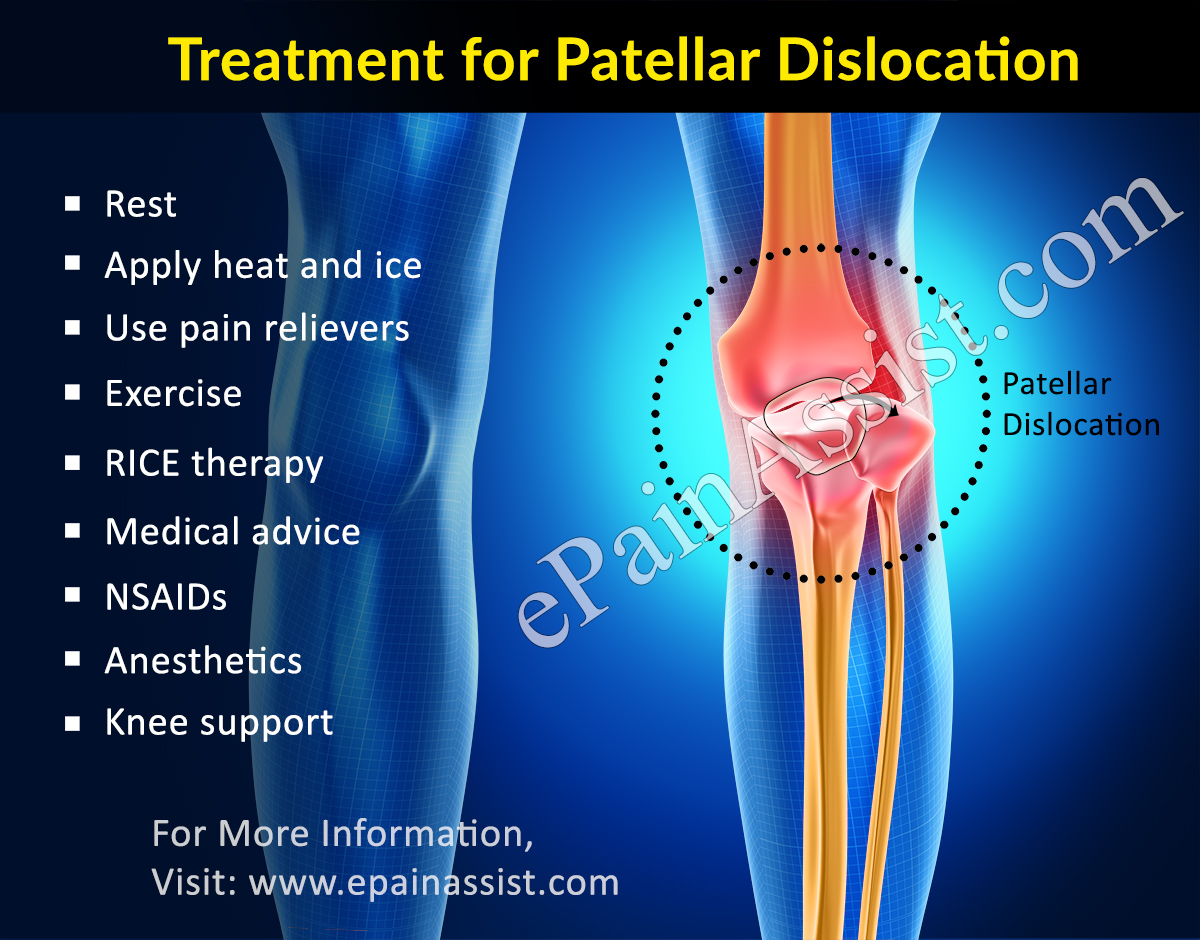Treatment for Patellar Dislocation or Kneecap Dislocation
Reduction is a procedure that a doctor will have to perform to manipulate back the kneecap, if by the time you get to hospital; the Patellar Dislocation or Kneecap Dislocation has not corrected itself.

Treating a Minor Patellar Dislocation or Kneecap Dislocation
Sedatives can help you relax and free you from pain associated with Patellar Dislocation or Kneecap Dislocation. Confirming the position of the bones and ruling out other injuries is the next task following kneecap repositioning. Though plaster casts (detachable splint) are seldom used today, you will need for your leg immobilization and you will have to have pain killers as you go home. To recover from Patellar Dislocation or Kneecap Dislocation you will need physical therapy lasting up to 6 weeks.[1]
If a fracture has a bone floating on your knee, you will be needing surgery.
Medicines Prescribed for Patellar Dislocation or Kneecap Dislocation
Pain medicines, (NSAIDs) and acetaminophen are medication used in treating Patellar Dislocation or Kneecap Dislocation. Prior to prescription of these medicines you should review contradictions, adverse effects and allergies first.
NSAIDs for Patellar Dislocation or Kneecap Dislocation
- Naproxen (Anaprox, Naprelan, Naprosyn, Aleve)
- Ibuprofen (Advil, Ibuprin, Motrin, Excedrin IB)
- Ketoprofen (Orudis, Acrtron, Oruvail)
Analgesics for Patellar Dislocation or Kneecap Dislocation
- Acetaminophen (tempra, Tylenol, aspirin-free Anacin, Tempra)
- Acetaminophen/codeine (Tylenol-3)[2]
Surgical Treatment for Patellar Dislocation or Kneecap Dislocation
If a ligament is damaged due to Patellar Dislocation or Kneecap Dislocation; reconstruction will often be done on the patellofemoral ligament (damaged ligament) in a surgery using a donated tendon.[3] If the articular cartilage is damaged in the joint, it can be treated asthroscopically. Arthritis can develop if the issues affecting your knee are not addressed because it will be chronically unstable.
Rehabilitation for Patellar Dislocation or Kneecap Dislocation
Tracking of the patella is the primary emphasis that is promoted to be stronger, faster and fitter is the focus of rehabilitation after reconstruction of the ligaments of patellofemoral. Depending on the individual’s situation, the surgeon will recommend the time which the healing process required for the repairing of the ligaments, should be. This is during the first month and while the patient maintains a given range of motion. With the continued progress of the patient in the program, strengths and stabilization activities that are with lower extremity and, are specific, are introduced. Transitioning to specific training is the focus in the last months of rehab program.[4]
The kneecap of some people is chronically loose, owing to bony shaped like a flat trochlea (anterior fumer) combined with the stretchy tissues (tissue laxity). In this circumstance, prior to undertaking any surgical procedure, there must be a prescribed muscle guide that is focused on strengthening exercise and careful physical therapy.
Consultations for Patellar Dislocation or Kneecap Dislocation
If the symptoms are still experienced by the patient when conservative management is used, hence it is not effective. Consider an orthopedic surgeon. You should pay particular attention to symptoms of intra-articular foreign body, like clicking, persistent pain or the locking of the intra-aticular knee. These might be symbolizing occult loose within your knee.
Physical Therapy (PT) for Treating Patellar Dislocation or Kneecap Dislocation
You will have to stop activities placing excessive loads, relieving pain and inflammation reduction on your patellofemoral joint is the immediate goal following an acute phase of dislocation or injury of the patellar. PRICE principle should be used in the management of acute phase: Protecting the injured joint, Resting relatively, Icing, Compressing and Elevating for effective inflammation control.
The healing process, reduction of recurrence probability and assurance of optimal results can be enhanced through Physical therapy. PT for Patellar Dislocation or Kneecap Dislocation may include: Massaging soft tissues, Electrotherapy, Using crutches, Using knee immobilization brace, Reposition of the patella by bracing or taping, Dry needling, Mobilization, Hydrotherapy, Heat or ice treatment, Strength, balance and flexibility improvement through progress exercise (VMO muscle particularly), Activity modification advice, Anti-inflammatory advice, Biomechanical correction, A program to return to activity gradually, and Assessing and retraining the muscle using Real-Time Ultrasound.[5]
Lifestyle Changes for Patellar Dislocation or Kneecap Dislocation
After dislocation treatment, try the following steps to lessen the discomfort and enhance healing following treatment of an injury resulting in Patellar Dislocation or Kneecap Dislocation:
- Rest the kneecap dislocated joint. Avoid the activity that gave rise to the injury, and avoid movements that are painful.
- Apply heat and ice. Pain and inflammation will be reduced by putting ice on the joint that is injured. Use a cold pack for 15-20 minutes every time. Do this for a couple of hours daily during the first two days. After two or three days have elapsed, with the improvement of the pain and inflammation, the sore and tightened muscles can be relaxed by using heating pad or hot packs. Apply the heating for 20 minutes every time.
- Use pain relievers. OTC (over the counter) drugs like naproxen (Aleve), acetaminophen Tylenol, others) or ibuprofen (Motrin IB, Advil, others) can be help with pain reliever.
- You joint’s range of motion should be maintained. As directed by your doctor, you should do some gentle exercise after one or two days so has to help in the maintaining the range of motion of the injured joint. Stiff joints might be caused by total inactivity.
- RICE therapy can be applied to the affected knee.[6]
- Medical advice should be sought.
- Exercises should be done in order to strengthen the VMO.
- NSAIDs such as ibuprofen help in decreasing the pain and inflammation due to patellar dislocation or dislocated kneecap.
- Anesthetics help in decreasing the pain due to patellar dislocation or dislocated kneecap.
- Knee support should be used to keep the patella immobile.
- Glucosamine/joint healing supplements are beneficial for treating dislocated kneecap.[7]
- https://www.ncbi.nlm.nih.gov/books/NBK482427/
- https://www.ncbi.nlm.nih.gov/pmc/articles/PMC3445142/
- https://www.winchesterhospital.org/health-library/article?id=886487
- https://www.ncbi.nlm.nih.gov/pmc/articles/PMC4685189/
- https://clinicaltrials.gov/ct2/show/NCT02185001
- https://www.healthlinkbc.ca/health-topics/tw4354spec#:~:text=As%20soon%20as%20possible%20after,Rest.
- https://www.ncbi.nlm.nih.gov/pmc/articles/PMC3150191/
Also Read:
